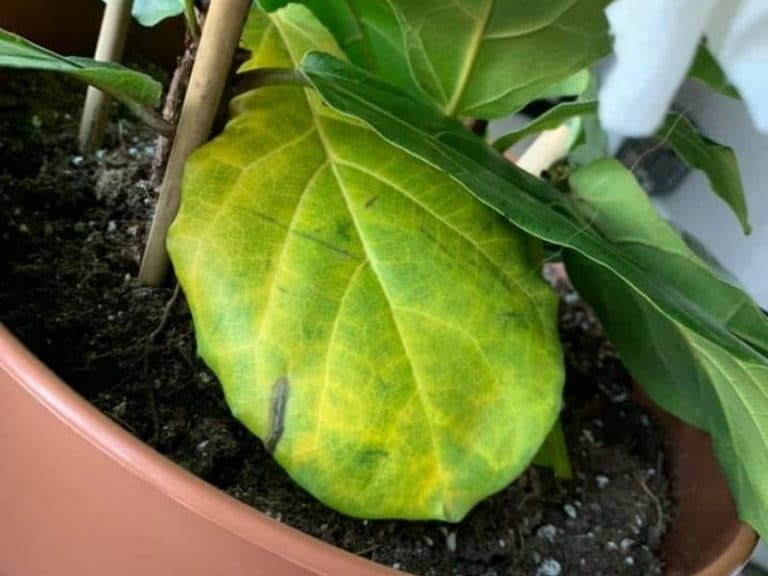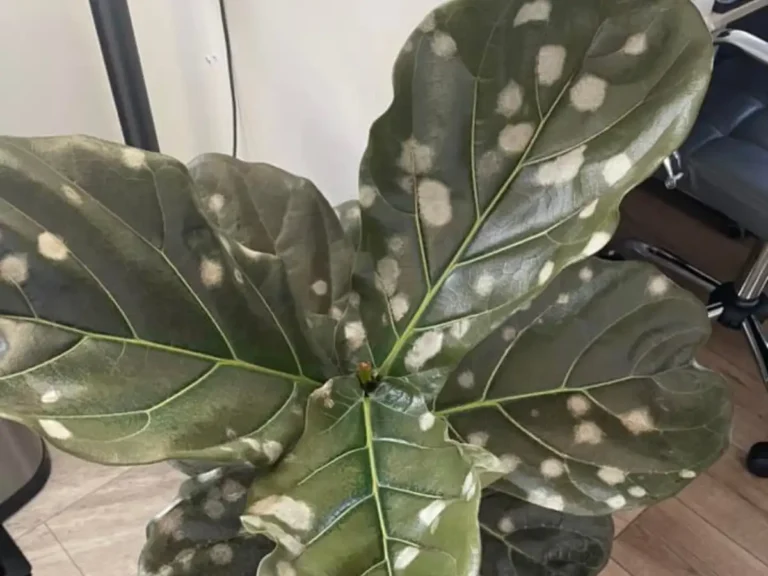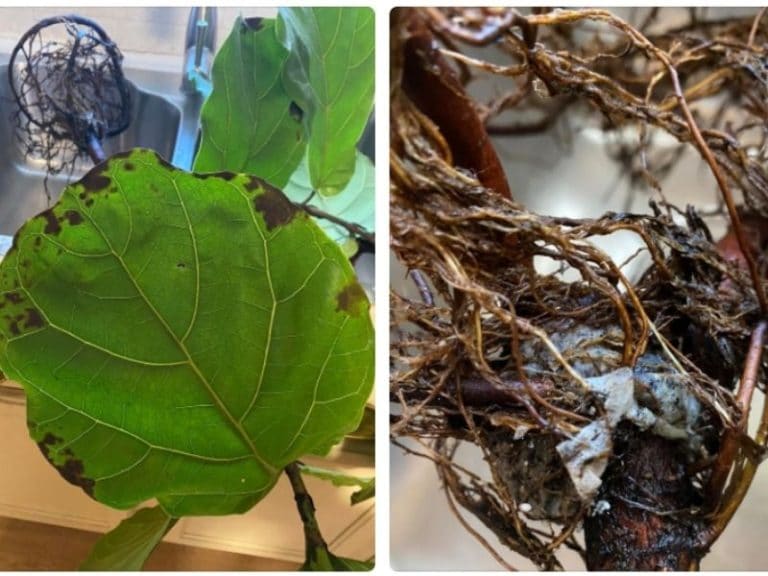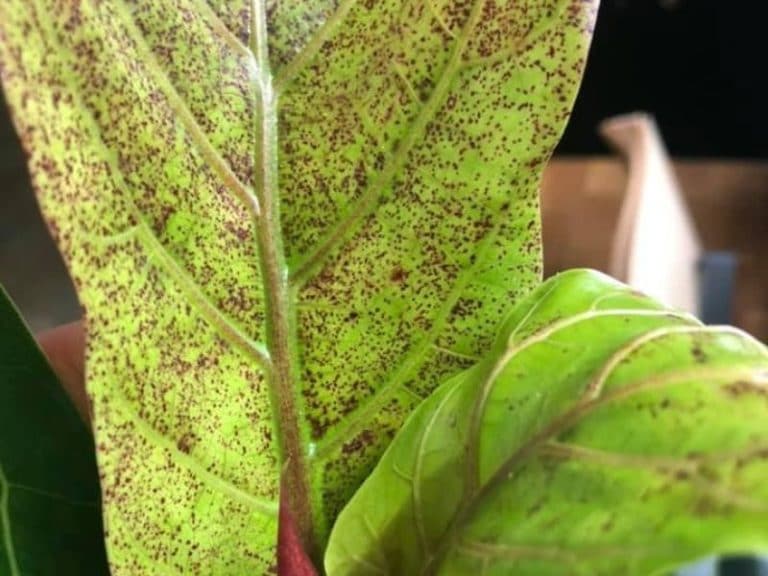Best Soil for Fiddle Leaf Figs
Fiddle leaf figs can be very sensitive to soil quality. The first sign of poor soil in fiddle leaf figs is the yellowing of leaves and slowed growth. If you want this indoor tree to grow fast and remain healthy, pot it using the right type of soil.
The best soil mix for fiddle leaf figs should be a well-draining, well-aerated, lightweight soil with a pH between 5.5 and 7.0. Some of the best potting mixes you can use include Premium fiddle leaf fig potting mix, MiracleGro, and peat moss. These allow the plant’s roots to breathe and prevent overwatering.
For a DIY potting soil for fiddle leaf figs, mix ⅔ peat to ⅓ perlite to improve the soil’s organic content and drainage.
What is the best soil for fiddle leaf figs?

The best soil for fiddle leaf figs is peat moss, Premium fiddle leaf fig potting mix, and MiracleGro Indoor Potting Mix. Some are made specially for growing fiddle leaf figs, and some are general houseplant potting mixes. They provide structural support, organic matter, aeration, and good drainage, promoting healthy fiddle leaf figs growth.
You can mix the soils yourself or buy a ready-to-use potting mix from your nearest garden store. Here are the best soils for fiddle leaf figs:
Premium fiddle leaf fig potting soil
Fiddle leaf fig lovers make this potting mix at the Fiddle Leaf Fig Plant Resource Center. Premium fiddle leaf fig potting soil is created specifically for growing fiddle leaf figs. But you can also use the potting mix on other indoor plants that thrive in well-draining soil.
Premium fiddle leaf fig potting mix is made from certified wood biochar, perlite, coco coir, organic aged bark, and green compost. The ingredients are mixed to optimal water and air balance.
Coco coir enhances the potting soil’s absorbency, drainage, and water retention. On the other hand, organic aged bark has several airspaces and a low water holding capacity. Therefore, it promotes aeration and firm root anchorage for fiddle leaf figs.
The certified wood biochar in the potting mix also increases the retention of essential plant nutrients like nitrogen and phosphorus to promote healthy and robust growth. Most importantly, perlite improves insulation, aeration, and drainage.
Thus, the premium fiddle leaf fig potting mix will protect your plant against overwatering and underwatering.
Pros
● Creates perfect root aeration for fiddle leaf figs
● It prevents root rot in your plants
● Rich in organic matter
● High-temperature sterilization rids the potting mix of all bacteria, fungus, and insects.
● The bag is resealable for easy storage
Cons
● Premium fiddle leaf fig potting mix is quite expensive
● Bags have little soil.
Miracle-Gro Indoor Potting Mix
Unlike the Premium fiddle leaf fig potting soil, which is made specially for the plant, MiracleGro indoor potting mix can help several houseplants. The potting mix contains both micronutrients and macronutrients. It has fertilizer prills that will fertilize your fiddle leaf fig for six months.
Sphagnum peat is the critical ingredient in MiracleGro indoor potting mix. Sphagnum peat holds a lot of water, allowing you to space out your watering for the fiddle leaf fig. The other ingredients include coco coir, perlite, and plant food.
Some users have reported fungi and gnat infestations after using MiracleGro indoor potting mix. However, the manufacturer maintains that their ingredients do not shelter gnats. The potting mix does not contain ingredients such as compost or bark that shelter fungus gnats.
Pros
● Fairly inexpensive
● Works with a variety of houseplants
● Less prone to fungus gnats
● MiracleGro indoor potting mix will feed your fiddle leaf fig for six months.
● Holds and releases water easily when the plant needs a drink
Cons
● It would help if you had a fresh MiracleGro indoor potting mix to repot your plant annually.
● Bag not resealable
DIY fiddle leaf fig potting soil
You can find Premium fiddle leaf potting soil and MiracleGro indoor potting mix at your nearest garden store. However, you could mix one at home instead of buying readily mixed potting soil for your fiddle leaf figs.
A DIY fiddle leaf fig potting soil can be cheap, but it takes time to mix. You will need to buy perlite, peat moss, and coco coir for a DIY potting soil for your fiddle leaf figs. Mix ⅔ peat to ⅓ perlite to improve the soil organic matter and drainage. Most importantly, add two parts of organic soil. It provides anchorage and nutrients to the plant.
If the fiddle leaf fig sits in water, root rot occurs. In that case, you may notice drooping leaves, brown spots, and yellowing and falling leaves. That means your potting mix is poorly-draining.
When preparing the soil, remember that the plant thrives at a slightly acidic pH. A pH between 5.5 and 7.0 is recommended. However, fiddle leaf figs can handle a slight pH deviation outside that range. There is no need to worry because the peat moss will provide the required acidity.
Pros
● Good drainage and aeration
● Supplies organic nutrients to the fiddle leaf fig
● Holds sufficient moisture
● It is effective against overwatering and underwatering
Cons
● A DIY fiddle leaf potting soil may contain harmful bacteria, fungi, and diseases.
● You may not get an even blend of the potting mix.
Therefore, you can make the best soil for fiddle leaf figs or buy either MiracleGro Indoor Potting Mix or the Premium Fiddle Leaf Fig Potting Soil. Since fiddle leaf figs are sensitive to drainage and aeration, these soils will be particularly essential to your plant’s health.
Best types of soil for fiddle leaf figs
The best soil types for fiddle leaf figs are perlite, peat moss, and compost.
Here are the different types of soil and soil mixes and their unique benefits:
Perlite
Perlite occurs naturally as a volcanic mineral with water trapped inside it. However, the raw material we use for growing houseplants is converted at high temperatures. That is why it is lightweight and highly porous.
As a result, perlite improves drainage, aeration, and insulation for your fiddle leaf figs. You can use perlite alone or mix it with clay or organic soil to improve the soil texture and speed up the growth and rooting of your houseplants.
Peat Moss
Although it is preferred for starting seeds, peat moss can significantly benefit your fiddle leaf figs. Unlike perlite, peat moss is poor in nutrients. Avoid growing your houseplants in peat moss alone. Your plants may not grow strongly and adequately.
As a soil amendment, peat moss holds a lot of water, which it releases when the plants need it. If you water your fiddle leaf fig, you may rinse the nutrients. However, adding peat moss to your plant will hold the nutrients even when you water your fiddle leaf fig. In other words, peat moss helps with drainage and nutrient retention.
Compost
Like with peat moss, I don’t recommend growing your houseplants directly on compost. Although compost is bulky and well aerated, 100 percent compost may lack a water retention capacity. In that case, mix one-part compost with four parts of soil.
Compost is so rich in nutrients that mixing it with other potting mixes adds calcium, nitrogen, potassium, phosphorus, magnesium, and sodium to the soil. Most importantly, it introduces beneficial microbes to the soil that will add nutrients for your fiddle leaf figs.
Perlite-Peat Moss Mix
A perlite and peat moss mixture is suitable for growing fiddle leaf figs. Adding organic soil to the mixture is also a good idea. It gives your plant the best chance to thrive. Mix perlite, peat moss, and organic soil in the ratio of 1:1:2.
The peat moss plays an essential role in managing the soil’s pH. This potting soil mix can absorb water and improve drainage for your fiddle leaf fig, thereby lowering the risks of root rot and insect infestations.
Soil Requirements for Fiddle Figs
Fiddle leaf figs thrive in fast-draining soils. The container should also be large enough for even moisture and root distribution. A container with plenty of room reduces wetness and sogginess, ensuring your plant never sits in the water.
A soil pH of around six and seven is key to the health of fiddle figs. The soil should be rich in humus. It helps the soil absorb and retain moisture. Humus also supplies the fiddle leaf fig with nutrients such as carbon, phosphorus, and potassium.
For a happy fiddle leaf fig, ensure the soil is fast draining with a pH of around 6-7 and enough humus.
Can I use succulent soil for pothos?
Succulent soil has nearly all the characteristics of the best soil for fiddle leaf figs. For example, the soil drains perfectly, holding moisture and nutrients. However, I recommend using succulent soil to grow fiddle leaf figs in a hardy landscape.
If you are growing the plant in a container, you should use a DIY fiddle leaf potting soil or purchase the Premium fiddle leaf fig potting soil, which is made specifically for the plant.
Can I use regular potting soil for fiddle leaf figs?
Although fiddle leaf fig can be sensitive to soil quality and drainage, the plant can still do well in regular potting soil. Regular potting soil contains some essential ingredients like composted sawdust, pine bark, and peat moss.
In other words, the fiddle leaf figs will still enjoy adequate soil drainage and aeration. If you use regular potting soil for fiddle leaf fig, do so for the short term. Generally, consider applying the best soil for fiddle leaf figs mentioned above.
References
- Brasher, K. (2016). Using Biochar As Container Substrate For Plant Growth. Mississippi State University.
- IFAS Extension. (2021). Homemade Potting Mix. The University of Florida.






